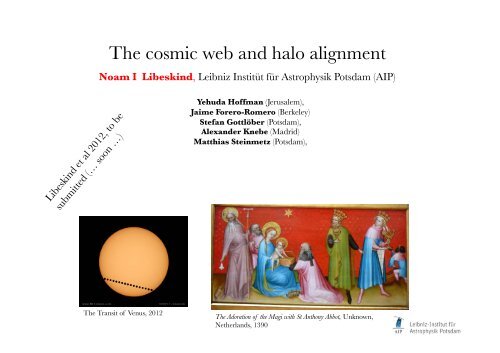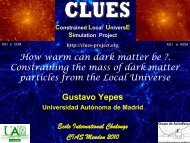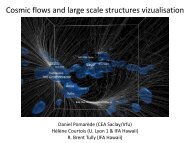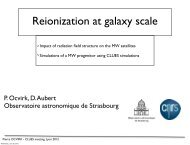The cosmic web and halo alignment - CLUES-Project
The cosmic web and halo alignment - CLUES-Project
The cosmic web and halo alignment - CLUES-Project
Create successful ePaper yourself
Turn your PDF publications into a flip-book with our unique Google optimized e-Paper software.
<strong>The</strong> <strong>cosmic</strong> <strong>web</strong> <strong>and</strong> <strong>halo</strong> <strong>alignment</strong><br />
Noam I Libeskind, Leibniz Institüt für Astrophysik Potsdam (AIP)<br />
Yehuda Hoffman (Jerusalem), <br />
Jaime Forero-Romero (Berkeley)<br />
Stefan Gottlöber (Potsdam), <br />
Alex<strong>and</strong>er Knebe (Madrid) <br />
Matthias Steinmetz (Potsdam), <br />
<strong>The</strong> Transit of Venus, 2012<br />
<strong>The</strong> Adoration of the Magi with St Anthony Abbot, Unknown,<br />
Netherl<strong>and</strong>s, 1390
Galaxy <strong>and</strong> satellite galaxy <strong>alignment</strong>s<br />
<strong>The</strong> <strong>alignment</strong> of satellite galaxies (the “disc of<br />
Satellites”) is a thorn in the side of CDM<br />
May be due to preferential infall, but… from<br />
where?<br />
Pawlowski et al 2012<br />
<strong>The</strong>refore, in order to keep me from becoming conceited, I<br />
was given a thorn in my flesh … to torment me. <br />
2 Corinthians 12:7<br />
Aqarius <strong>halo</strong>, Springel et al 2008
What causes the aniostropic infall of satellite galaxies? What determines their<br />
trajectory <strong>and</strong> orbit? Is it related to the large scale structure ?<br />
Galaxy spins are related to LSS – why not satellite trajectories?<br />
Lee & Erdogdu 2007:<br />
Alignment of a galaxy’s spin axis<br />
with the intermediate axes of the<br />
local shear tensor from the<br />
reconstructed tidal field of 2MASS
Tidal Torque theory predicts an <strong>alignment</strong> between J <strong>and</strong> the intermediate axis of the<br />
shear
Tidal Torque theory predicts an <strong>alignment</strong> between J <strong>and</strong> the intermediate axis of the<br />
shear<br />
Collapsing proto-<strong>halo</strong> at<br />
high redshift with Inertia<br />
Tensor of 2 nd moments<br />
I αβ
Tidal Torque theory predicts an <strong>alignment</strong> between J <strong>and</strong> the intermediate axis of the<br />
shear<br />
Collapsing proto-<strong>halo</strong> at<br />
high redshift with Inertia<br />
Tensor of 2 nd moments<br />
I αβ<br />
Δ<br />
Gravitational field<br />
(r) with gradient<br />
Δ
Tidal Torque theory predicts an <strong>alignment</strong> between J <strong>and</strong> the intermediate axis of the<br />
shear<br />
Collapsing proto-<strong>halo</strong> at<br />
high redshift with Inertia<br />
Tensor of 2 nd moments<br />
I αβ<br />
Δ<br />
Gravitational field<br />
(r) with gradient<br />
Δ<br />
tidal shear Σ αβ
Tidal Torque theory predicts an <strong>alignment</strong> between J <strong>and</strong> the intermediate axis of the<br />
shear<br />
Collapsing proto-<strong>halo</strong> at<br />
high redshift with Inertia<br />
Tensor of 2 nd moments<br />
I αβ<br />
Δ<br />
Gravitational field<br />
(r) with gradient<br />
Δ<br />
tidal shear Σ αβ<br />
Angular momentum<br />
acquired through tidal<br />
torques
Tidal Torque theory predicts an <strong>alignment</strong> between J <strong>and</strong> the intermediate axis of the<br />
shear<br />
Collapsing proto-<strong>halo</strong> at<br />
high redshift with Inertia<br />
Tensor of 2 nd moments<br />
I αβ<br />
Δ<br />
Gravitational field<br />
(r) with gradient<br />
Δ<br />
tidal shear Σ αβ<br />
Angular momentum<br />
acquired through tidal<br />
torques<br />
As the proto-<strong>halo</strong> collapses it decouples from the<br />
Shear flow; at some point the “lever arms” of the<br />
inertia tensor are too small for any more torques to<br />
be imparted. Tidal torques stop.
Tidal Torque theory predicts an <strong>alignment</strong> between J <strong>and</strong> the intermediate axis of the<br />
shear<br />
Angular momentum<br />
Inertia tensor <br />
Tidal shear <br />
In the principle axis of the shear<br />
, this can be written as<br />
Greatest, hence<br />
<strong>halo</strong> spin should<br />
align with the<br />
intermediate<br />
axis of the<br />
Shear<br />
Lee & Lee 2006<br />
Lee & Erdogdu 2008<br />
+ others
Shear can be used to quantify the Cosmic <strong>web</strong> (Bond et al 1996)<br />
Springel et al 2005<br />
How does the <strong>web</strong> effect galaxy formation?
<strong>The</strong> <strong>cosmic</strong> <strong>web</strong> can be classified either by looking at the velocity shear tensor<br />
We can diagonalize the shear tensor to obtain the eigenvectors ê i <strong>and</strong> eigenvalues λ i .<br />
(Order them such that λ 1 >λ 2 >λ 3 )<br />
By counting the number of eigenvalues above a given threshold λ th we can classify<br />
each point (cell) in space according to the <strong>web</strong> <br />
See Ofer Metuki’s talk
<strong>The</strong> <strong>cosmic</strong> <strong>web</strong> can be classified either by looking at the velocity shear tensor<br />
We can diagonalize the shear tensor to obtain the eigenvectors ê i <strong>and</strong> eigenvalues λ i .<br />
(Order them such that λ 1 >λ 2 >λ 3 )<br />
By counting the number of eigenvalues above a given threshold λ th we can classify<br />
each point (cell) in space according to the <strong>web</strong> <br />
Simulation Grid smoothing shear<br />
See Ofer Metuki’s talk
VOID λ th >λ 1 >λ 2 >λ 3 All three eigenvectors of<br />
the shear tensor are exp<strong>and</strong>ing<br />
SHEET λ 1 > λ th ; λ 2 ,λ 3 < λ th Collapse along one axis<br />
(ê 1 ), expansion along the two (ê 2 , ê 3 )<br />
ê 1 <br />
FILAMENT λ 1, λ 2 > λ th ; λ 3 < λ th Collapse along two<br />
axes (ê 1, ê 2 ), expansion along the other (ê 3 ) <br />
KNOT λ 1 >λ 2 >λ 3 >λ th All three eigenvectors of the<br />
shear tensor are collapsing<br />
ê 3
Bolshoi (Klypin et al 2011)<br />
L box =250 h -1 Mpc with <br />
2048 3 ≈ 8 billion particles<br />
m DM ∼ 1.3 × 108 h 1 M ⊙ <br />
r soft ∼ 1 kpc.<br />
256 3 grid cells = ~1 Mpc<br />
This is a kinematical classification, not a geometric<br />
one – hence it is interesting to compare with kinematic<br />
<strong>halo</strong> properties such as <strong>halo</strong> spin <strong>and</strong> sub<strong>halo</strong> orbital<br />
angular momentum<br />
h=0.7, <br />
Ω =0.73,<br />
Ω m =0.27,<br />
Ω b =0.046,<br />
n= 0.95<br />
8 = 0.82.
Grid size selection is important: <br />
BAD! <br />
We want to probe the Large Scale (> rvir)<br />
<strong>alignment</strong> not the internal <strong>alignment</strong>.<br />
GOOD!
<strong>The</strong> distribution of measured eigenvalues<br />
Mass dependent bias – More massive <strong>halo</strong>es, the<br />
greater the eigenvalues<br />
Just as the distribution of <strong>halo</strong>es is biased towards<br />
high density peaks so to is the value of the <strong>cosmic</strong><br />
shear.
How can we quantifying the uniformity of the eigenvalues<br />
1. Triaxiality: <br />
(λ 12 -λ 3<br />
2<br />
)/( λ 12 -λ 22 ) FAILS since the ordering of λ’s is by value not magnitude<br />
2. Eigenvalue ratio <br />
λ 1 /λ 3<br />
FAILS for the same reason – also sign makes it a problem<br />
3. Bardeen et al 1986, eccentricty<br />
e = (λ 1 -λ 3 )/ 2 | λ 1 +λ 2 +λ 3 |<br />
FAILS when e.g. λ 1 ~ - λ 3 <strong>and</strong> λ 2 ~ 0, e infty. Also, unbound <br />
All these measures are WEB TYPE DEPENDENT
Quantifying the uniformity of the shear with the Fractional Anisotropy FA:<br />
P. J. Basser Inferring microstructural features <strong>and</strong> the physiological state of tissues from diffusionweighted<br />
images. NMR in Biomedical Imaging, 8, 333 (1995)
Quantifying the uniformity of the shear with the Fractional Anisotropy FA:<br />
P. J. Basser Inferring microstructural features <strong>and</strong> the physiological state of tissues from diffusionweighted<br />
images. NMR in Biomedical Imaging, 8, 333 (1995)
Quantifying the uniformity of the shear with the Fractional Anisotropy FA:<br />
No anisotropy<br />
A lot of anisotropy
Quantifying the uniformity of the shear with the Fractional Anisotropy FA:<br />
1. Knots are the most<br />
isotropic<br />
2. Voids are highly<br />
anisotropic<br />
3. Sheets <strong>and</strong> filaments<br />
span many anisotropy<br />
types<br />
No anisotropy<br />
A lot of anisotropy
(1) Calculate Shear eigenvalues<br />
(2) Looked at their distribution <strong>and</strong> quantified their isotropy<br />
(3) How are <strong>halo</strong>es aligned<br />
with the <strong>web</strong> (eigenvalues)<br />
<strong>and</strong> how does this depend on<br />
isotropy?
Alignment of <strong>halo</strong> shape – <strong>halo</strong> is defined by the inertia tensor a, b, c <br />
a<br />
b<br />
c
Alignment of <strong>halo</strong> shape – <strong>halo</strong> is defined by the inertia tensor a, b, c <br />
Use the principle axes of the <strong>web</strong> ê 1, ê 2, ê 3 <strong>and</strong> construct angular distribution of<br />
a . ê 3 , b . ê 2 , c . ê 1 <br />
c<br />
b<br />
a
c<br />
b<br />
a<br />
Web INDEPENDENT<br />
Strength is mass DEPENDENT<br />
Statistically significant <strong>alignment</strong> of a with ê 3 <br />
at all masses
Knots Filaments Sheets Voids<br />
Web INDEPENDENT (a bit stronger in<br />
voids: could be statistical )<br />
Strength is mass DEPENDENT<br />
Statistically significant <strong>alignment</strong> of a with ê 3 <br />
at all masses
spin <strong>alignment</strong><br />
Look at the angle formed between a <strong>halo</strong>’s<br />
spin <strong>and</strong> the principle axes of the <strong>cosmic</strong><br />
<strong>web</strong><br />
- Alignment with e 2 is confirmed
spin <strong>alignment</strong><br />
Look at the angle formed between a <strong>halo</strong>’s<br />
spin <strong>and</strong> the principle axes of the <strong>cosmic</strong><br />
<strong>web</strong>
Low mass <strong>halo</strong>es aligned with ê 3<br />
High mass <strong>halo</strong>es aligned perpendicular to ê 3<br />
Spin flip occurs at 1e12 (Codis et al, Aragon-<br />
Calvo et al) as a <strong>halo</strong>’s merger history goes<br />
from being accretion dominated to merger<br />
dominated
Spin <strong>alignment</strong> is <strong>web</strong> independent, but the mass<br />
transition is <strong>web</strong> dependent.
Spin <strong>alignment</strong> is <strong>web</strong> independent, but the mass<br />
transition is <strong>web</strong> dependent. <br />
“parallel”<br />
“perpendicular”<br />
Does the uniformity of the shear play a role?
High anisotropy<br />
Low anisotropy<br />
Mass of <strong>halo</strong> is correlated with the FA
Mass is constant with respect to<br />
FA until a critical mass after which<br />
mass becomes correlated with FA.<br />
Knots ~ 10 12.8 M sol<br />
Filaments ~ 10 12.4 M sol<br />
Sheets ~ 10 11.8 M sol<br />
Voids ~ 10 11.4 M sol<br />
”Low” mass <strong>halo</strong>es exist in<br />
regions of any FA, while high<br />
mass <strong>halo</strong>es tend to prefer low FA<br />
Mass of <strong>halo</strong> is correlated with the FA
Alignment of J with e 3 following<br />
these cuts gives the proper mass<br />
of the transition<br />
Knots ~ 10 12.8 M sol<br />
Filaments ~ 10 12.4 M sol<br />
Sheets ~ 10 11.8 M sol<br />
Voids ~ 10 11.4 M sol
Alignment of sub<strong>halo</strong> orbital J with shear<br />
divided by parent <strong>halo</strong> mass<br />
R<strong>and</strong>om except for the largest parent <strong>halo</strong>es
Conclusions<br />
1. Strong <strong>alignment</strong> found between a <strong>halo</strong>’s shape <strong>and</strong> the <strong>cosmic</strong> <strong>web</strong><br />
2. An <strong>alignment</strong> is also found between the Spin <strong>and</strong> the <strong>cosmic</strong> <strong>web</strong> – the sense of<br />
which is mass dependent – high mass <strong>halo</strong>es spin perpendicular to e 3 . <br />
3. <strong>The</strong> mass transition at which <strong>halo</strong>es go from spinning parallel to perpendicular is<br />
<strong>web</strong> dependent<br />
4. <strong>The</strong> <strong>cosmic</strong> shear eigenvalue relationship can be characterized with the fractional<br />
anisotropy<br />
5. <strong>The</strong>re exist a mass above which <strong>halo</strong> mass correlates with FA<br />
6. That mass is roughly the same at which <strong>halo</strong> spin flips<br />
7. Sub<strong>halo</strong> orbits also reflect the large scale structure
We can test for the effects of grid resolution by refining it to span 1000 3 cells = 250 kpc <br />
Upper Mass limit is thus ~10 11.5 Msol<br />
M< 10 10<br />
10 10
We can test for the effects of grid resolution by refining it to span 1000 3 cells = 250 kpc <br />
Upper Mass limit is thus ~10 11.5 Msol<br />
M< 10 10<br />
10 10
Conclusions<br />
1. Strong <strong>alignment</strong> found between a <strong>halo</strong>’s shape <strong>and</strong> the <strong>cosmic</strong> <strong>web</strong><br />
2. An <strong>alignment</strong> is also found between the Spin <strong>and</strong> the <strong>cosmic</strong> <strong>web</strong> – the sense of<br />
which is mass dependent – high mass <strong>halo</strong>es spin perpendicular to e 3 . <br />
3. <strong>The</strong> mass transition at which <strong>halo</strong>es go from spinning parallel to perpendicular is<br />
<strong>web</strong> dependent<br />
4. <strong>The</strong> <strong>cosmic</strong> shear eigenvalue relationship can be characterized with the fractional<br />
anisotropy<br />
5. <strong>The</strong>re exist a mass above which <strong>halo</strong> mass correlates with FA<br />
6. That mass is roughly the same at which <strong>halo</strong> spin flips<br />
7. Sub<strong>halo</strong>e orbits also reflect the large scale structure<br />
THANK YOU!
After the tidal torques have been applied, what happens to the spins of <strong>halo</strong>es?<br />
What about their substructure orbital spin?<br />
What do numerical simulations indicate?<br />
Gravitational field (r)<br />
with gradient<br />
causes a tidal shear Σ αβ<br />
Δ<br />
As the proto-<strong>halo</strong> collapses it<br />
decouples from the Shear flow; at<br />
some point the “lever arms” of the<br />
inertia tensor are too small for any<br />
more torques to be imparted.<br />
Tidal torques stop.
How do galaxies/<strong>halo</strong>es get their spin?<br />
Mis-<strong>alignment</strong> between the inertia tensor <strong>and</strong> gravitational tidal tensor imparts torques <br />
Tidal Torque <strong>The</strong>ory (Hoyle 1949; Peebles 1969; Doroshkevich 1970; White 1984,<br />
Catelan & <strong>The</strong>uns 1996; Crittenden et al. 2001; Schäfer 2009)<br />
Gravitational field (r)<br />
with gradient<br />
causes a tidal shear Σ αβ<br />
Δ<br />
As the proto-<strong>halo</strong> collapses it<br />
decouples from the Shear flow; at<br />
some point the “lever arms” of the<br />
inertia tensor are too small for any<br />
more torques to be imparted.<br />
Tidal torques stop.
How do galaxies/<strong>halo</strong>es get their spin? Mis-<strong>alignment</strong> between the inertia tensor<br />
<strong>and</strong> gravitational tidal tensor imparts torques.<br />
Tidal Torque <strong>The</strong>ory (Hoyle 1949; Peebles 1969; Doroshkevich 1970; White 1984,<br />
Catelan & <strong>The</strong>uns 1996; Crittenden et al. 2001; Schäfer 2009)<br />
Collapsing proto-<strong>halo</strong> at high redshift<br />
with Inertia Tensor of 2 nd moments I αβ
How do galaxies/<strong>halo</strong>es get their spin?<br />
Mis-<strong>alignment</strong> between the inertia tensor <strong>and</strong> gravitational tidal tensor imparts torques <br />
Tidal Torque <strong>The</strong>ory (Hoyle 1949; Peebles 1969; Doroshkevich 1970; White 1984,<br />
Catelan & <strong>The</strong>uns 1996; Crittenden et al. 2001; Schäfer 2009)<br />
Δ<br />
Gravitational field (r) with gradient<br />
Δ
How do galaxies/<strong>halo</strong>es get their spin?<br />
Mis-<strong>alignment</strong> between the inertia tensor <strong>and</strong> gravitational tidal tensor imparts torques <br />
Tidal Torque <strong>The</strong>ory (Hoyle 1949; Peebles 1969; Doroshkevich 1970; White 1984,<br />
Catelan & <strong>The</strong>uns 1996; Crittenden et al. 2001; Schäfer 2009)<br />
Gravitational field (r) with gradient<br />
causes a tidal shear Σ αβ<br />
Δ
How do galaxies/<strong>halo</strong>es get their spin?<br />
Mis-<strong>alignment</strong> between the inertia tensor <strong>and</strong> gravitational tidal tensor imparts torques <br />
Tidal Torque <strong>The</strong>ory (Hoyle 1949; Peebles 1969; Doroshkevich 1970; White 1984,<br />
Catelan & <strong>The</strong>uns 1996; Crittenden et al. 2001; Schäfer 2009)<br />
Angular momentum acquired<br />
through tidal torques
VOID λ th >λ 1 >λ 2 >λ 3 All three eigenvectors of<br />
the shear tensor are exp<strong>and</strong>ing
VOID λ th >λ 1 >λ 2 >λ 3 All three eigenvectors of<br />
the shear tensor are exp<strong>and</strong>ing<br />
SHEET λ 1 > λ th ; λ 2 ,λ 3 < λ th Collapse along one axis<br />
(ê 1 ), expansion along the two (ê 2 , ê 3 )
VOID λ th >λ 1 >λ 2 >λ 3 All three eigenvectors of<br />
the shear tensor are exp<strong>and</strong>ing<br />
SHEET λ 1 > λ th ; λ 2 ,λ 3 < λ th Collapse along one axis<br />
(ê 1 ), expansion along the two (ê 2 , ê 3 )<br />
FILAMENT λ 1, λ 2 > λ th ; λ 3 < λ th Collapse along two<br />
axes (ê 1, ê 2 ), expansion along the other (ê 3 )
VOID λ th >λ 1 >λ 2 >λ 3 All three eigenvectors of<br />
the shear tensor are exp<strong>and</strong>ing<br />
SHEET λ 1 > λ th ; λ 2 ,λ 3 < λ th Collapse along one axis<br />
(ê 1 ), expansion along the two (ê 2 , ê 3 )<br />
FILAMENT λ 1, λ 2 > λ th ; λ 3 < λ th Collapse along two<br />
axes (ê 1, ê 2 ), expansion along the other (ê 3 ) <br />
KNOT λ 1 >λ 2 >λ 3 >λ th All three eigenvectors of the<br />
shear tensor are collapsing
Velocities exacerbate the situation<br />
<strong>and</strong> threaten the CDM model<br />
Pawlowski et al 2012 <br />
A minimum of 3 (<strong>and</strong> up to a<br />
maximum of 8) classical satellites<br />
appear to be moving within 30 deg<br />
of the normal to the <br />
plane they define.<br />
Libeskind et al 2009
Anisotropy of orbits at accretion leads to<br />
anisotropic z=0 distributions – preferential infall<br />
Libeskind et al 2011<br />
Knebe et al 2004<br />
+ Li & Helmi 2008, Lovell et al<br />
2011, Vera-ciro et al 2011 et cetera







![Constrained Local Universe Simulations [pdf, 19 MB] - CLUES-Project](https://img.yumpu.com/24321200/1/190x135/constrained-local-universe-simulations-pdf-19-mb-clues-project.jpg?quality=85)
